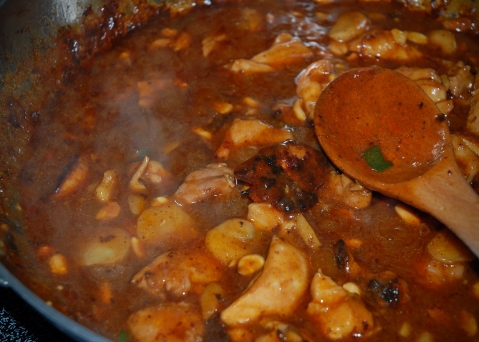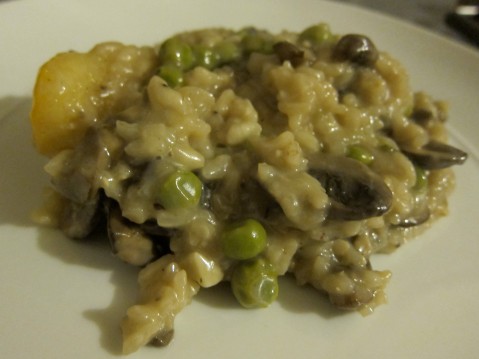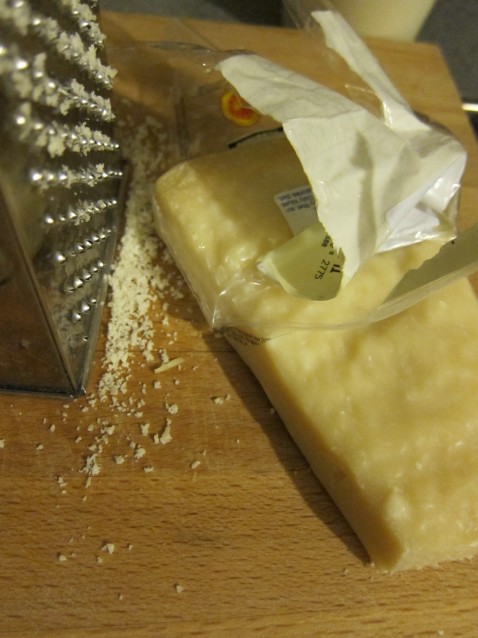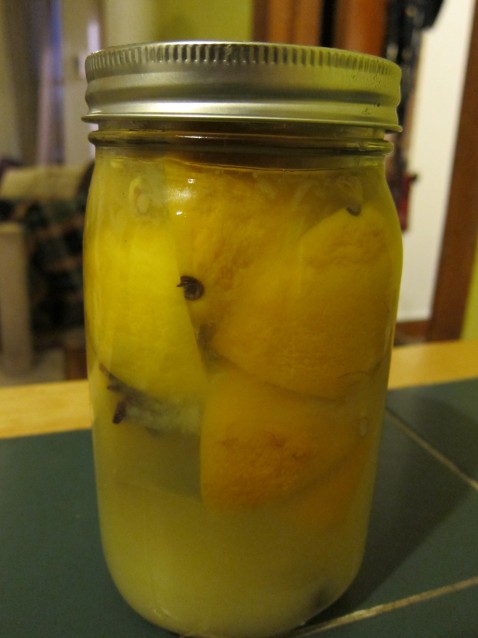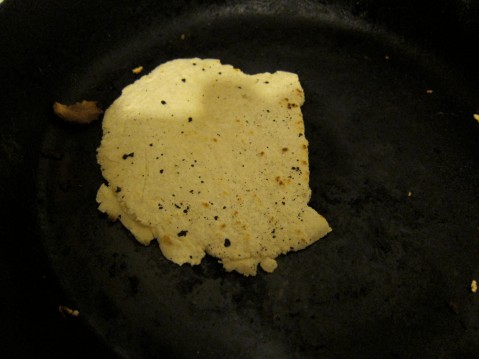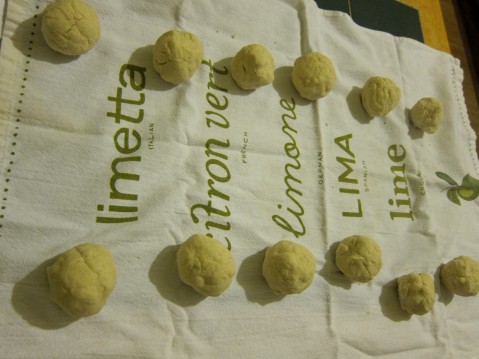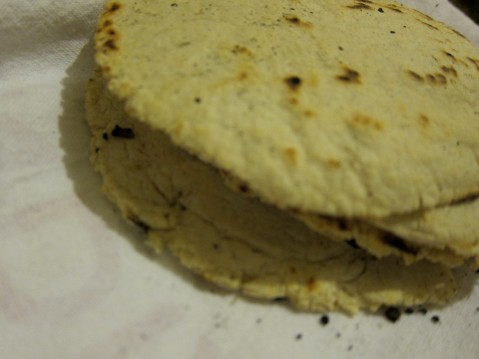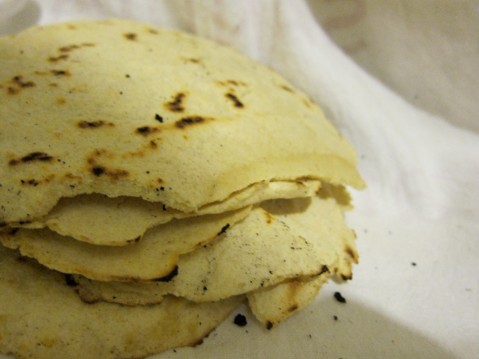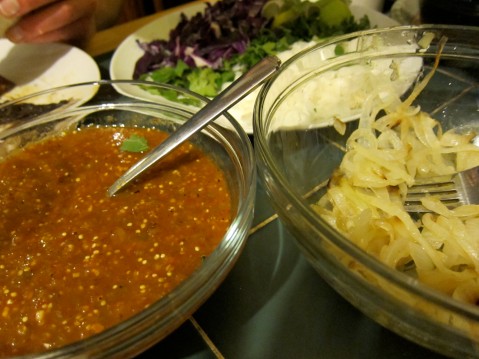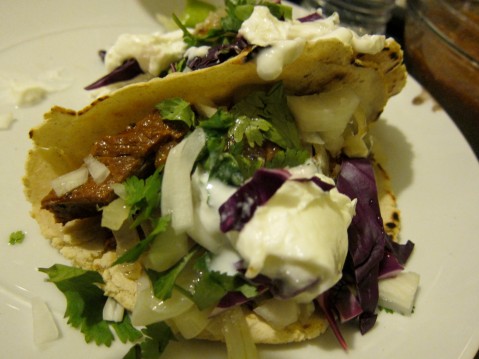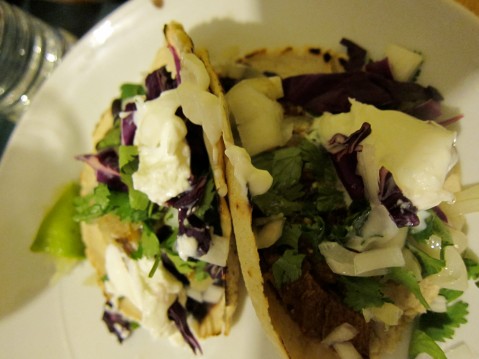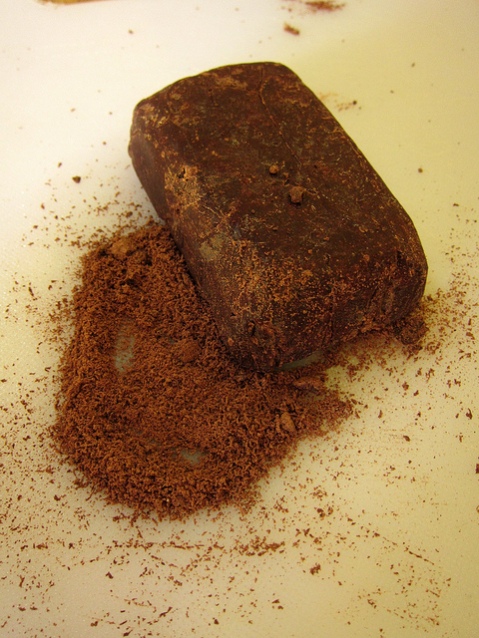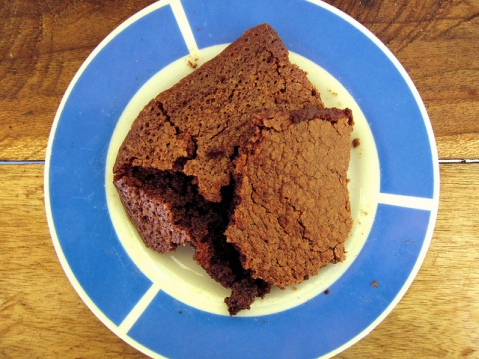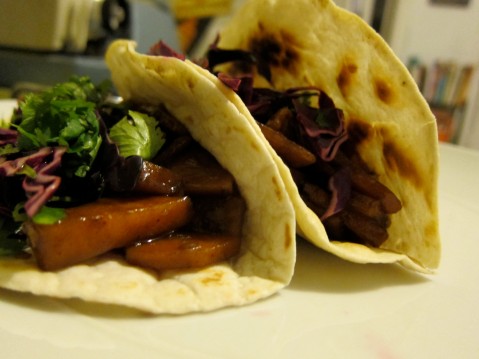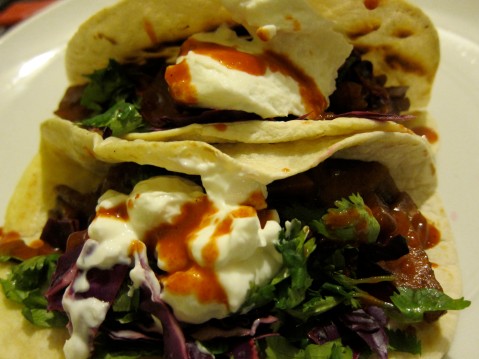Kung Pao Feast and Fortune Cookies
Siggy and Sara and I used to go to Big Bowl in Gold Coast a lot when Siggy lived there, and Siggy would order Kung Pao Chicken EVERY SINGLE TIME. So, when I found the recipe in a cookbook called Spices of Life, I knew I’d have to make it for her. And what better time than her birthday? A few weeks ago, we got together at Sara’s and had a feast. Angela made fortune cookies and Sizchuan green beans and Sara made a tofu version of the kung pao (using the same ingredients as those called for in the chicken marinade, and soaking the tofu overnight). What a spread!
Wikipedia tells me that it was politically incorrect until the 1980s to refer to this dish as Kung Pao in China, as it’s named after Ding Baozhen, a Qing Dynasty official (“kung pao” is derived from his title as palace guardian), who fell out of favor during the Cultural Revolution. In China, they call this dish fast-fried-chicken-cubes (hong bao ji ding). So, please enjoy these delicious fast fried chicken cubes, which are much easier to make than I’d thought. Or, as Angela put it: A delightful East meets West concoction, devoid of hatred and full of home-cooked energies.
Kung Pao Chicken (or Tofu)
from Nina Simonds’s Spices of LIfe
1 1/2 lb. boneless, skinless chicken meat (I used thighs)
(or extra firm tofu)
marinade
2 tbsp. soy sauce
2 tbsp. rice wine or sake
1 tsp. toasted sesame oil
1 tsp. cornstarch
4 1/2 tbsp. olive oil
seasonings
2 tbsp. minced scallions
1 1/2 tbsp. minced fresh ginger
1 1/2 tbsp. minced garlic
1 tsp. hot chile paste or dried chile flakes, to taste
1 1/2 c. thinly sliced water chestnuts, about 8 oz.
sauce
1/2 c. chicken broth or water
2 1/2 tbsp. soy sauce
2 tbsp. rice wine or sake
1 tsp. toasted sesame oil
1 tbsp. Chinese black vinegar or Worcestershire sauce
1 1/4 tsp. cornstarch
1 c. diced scallion greens
1 1/2 c. unsalted dry-roasted peanuts
Trim the chicken of any fat or gristle and cut into 1/2-inch cubes. Place in a bowl. Add the marinade and toss lightly to coat. Cover with plastic wrap and refrigerate for 20 minutes.
Heat a wok or a skillet, add 2 1/2 tbsp. of oil, heat until very hot, and add the chicken. Cook over high heat until the chicken becomes opaque and is cooked, about 3 to 4 minutes. Remove with a strainer and drain. Wipe out the pan.
Add the remaining oil and heat until hot. Add the seasonings and stir-fry briefly, about 15 seconds, then add the water chestnuts and stir-fry over high heat for about 1 1/2 minutes to heat through. Add the sauce and cook, stirring continuously to prevent lumps, until thickened. Return the cooked chicken to the pan and add the scallion greens and the peanuts. Toss lightly to coat and heat through. Serve with steamed rice.
Spicy Sichuan-Style Green Beans
from Nina Simmonds’s Spices of Life
2 1/2 lb. green beans, rinsed and drained
2 1/2 tbsp. olive oil
seasoning
1 1/2 tbsp. minced scallions, white part only
2 tbsp. minced garlic
1 tsp. hot chile paste or dried chile flakes
sauce
3/4 c. chicken broth
3 tbsp. soy sauce
2 1/2 tbsp. rice wine or sake
1 1/2 tbsp. sugar
1 tsp. toasted sesame oil
2 tsp. Chinese black vinegar or Worcestershire sauce
1 1/4 tsp. cornstarch
1/2 c. toasted sliced almonds for garnish
Trim the ends of the beans and cut the beans into 3-inch lenths.
Bring water to a boil in a medium pot. Add the green beans adn bring to a boil again. Reduce the heat to medium and cook uncovered for about 8 minutes, or until almost cooked but still crisp. Drain in a colander and refresh in cold water. Drain again.
Heat a wok or a deep skillet, add the oil and heat until hot. Add the seasonings. Stir-fry briefly, about 15 seconds, then add the sauce. Bring to a boil, stirring continuously to prevent lumps, until thickened. Return the cooked green beans to the pan, toss lightly to coat, and scoop onto a serving platter. Sprinkle with the toasted almonds.
Fortune Cookies…from Angela:
In keeping with the Chinese food-themed celebration of our dear Sigela, I offered to make fortune cookies. While I have many strengths (yelling imaginative profanities; delivering swift justice; dancing poorly), baking is not one of them and I was afraid I had bitten off more than I could chew (another one of my strengths). Nevertheless, I found this recipe very easy to put together, and after my first trial batch, I’d like to think I could medal in The North American Fortune Cookie Folding Finals. But practice makes perfect! I highly recommend making a trial batch before you go for the gold.
Fortune Cookies
From Martha Stewart (http://www.marthastewart.com/recipe/fortune-cookies)
5 tbsp. unsalted butter
4 large egg whites
1 c. superfine sugar
1 c. all-purpose flour, sifted
Pinch of salt
3 tbsp. heavy cream
1 tsp. almond extract
Nonstick cooking spray
Heat oven to 400 degrees. Spray a cookie sheet liberally with cooking spray (Note: For my first batch I made sure to spray the cookie sheet, but found that it was more wasteful than anything. There’s enough butter in here that your cookies shouldn’t stick if you’re using a non-stick sheet). Melt butter in a small saucepan over low heat; set aside.
In the bowl of an electric mixer (Note: I blended everything by hand and it came out just fine.) combine egg whites and sugar, and beat on medium speed, about 30 seconds. Add flour and salt, and beat until combined. Add butter, heavy cream, and almond extract, and beat until combined, about 30 seconds.
Using a regular teaspoon, spoon a glob of batter onto one half of the baking sheet, and spread with the back of the spoon into a thin 5-inch circle; repeat on the other half of the sheet. (The tricky part is ensuring that the batter is spread evenly enough.) Bake until the edges of the cookies turn golden brown. Martha suggests 8 minutes, but I found that 6 minutes was plenty of time in the oven.
Transfer baking sheet to a heat-resistant surface. Working as quickly as possible, slide a spatula under the cookies and place on a clean kitchen towel. Using your fingers, fold the cookie in half, pinching the top together to form a loose semicircle. Hold the cookie with your index fingers inserted at each open end, and slide your thumbs together along the bottom line. Press into the center of the cookie while bending the two open ends together and down to form the shape of a fortune cookie. This whole process should take about 10 seconds. Once the cookie hardens, which begins to happen almost immediately, you cannot fold it. Place the fortune cookie on the kitchen towel to cool, and shape the second cookie. Repeat until all the batter is used up. To speed up the process, bake four cookies at a time, staggering two cookie sheets by 4 minutes to give you time to shape. To avoid wasting batter, practice folding with a circle of paper first.
Write your message on a long strip of sturdy art paper. If you’re hardcore, you can place a strip of paper in the center of the cookie after you’ve baked it but before you fold it, but really I just rolled up a strip of paper and tucked it inside one of it’s cone-y halves.
Stay tuned! I intend to create a vegan version very soon…
Mushroom Pea Risotto
When standing over a pot of risotto, it’s not hard to imagine you’re stirring a bubbling cauldron of magical delights, like in Macbeth‘s witches’:
Poison’d entrails, toad, filet of a fenny snake, eye of newt, toe of frog, wool of bat, tongue of dog, adder’s fork, blind-worm’s sting, lizard’s leg, howlet’s wing, scale of dragon, tooth of wolf, witches’ mummy, maw and gulf of ravin’d salt-sea shar, root of hemlock digg’d i’ the dark, liver of blaspheming Jew, gall of goat, slips of yew, nose of Turk, Tartar’s lips, finger of birth-strangled babe, tiger’s chaudron, baboon’s blood.
I like the care involved with making risotto. It’s mostly about stirring and timing, but it’s a food that wants your attention. By the end, you’ve seen it through each step of the way; you’ve stood over the hot stove for a good 35-40 minutes, smelling the layers as you build: garlic and shallots, mushrooms, reducing wine, sage, stock, lemon. I think it’s a really gratifying concoction to make. Perfect for a cold night.
The preserved lemon is the secret eye of newt in this version. It ties all the flavors together and makes them just a little bit magic.
Mushroom Pea Risotto
12 oz. stock
olive oil
3–4 garlic cloves, peeled and finely diced
2 large shallots, peeled and finely diced
3 sage leaves
1 lb. crimini mushrooms, roughly diced
1 c. white wine
1 c. arborio rice
1 bay leaf
1 preserved lemon
1 c. frozen peas
1 c. grated parmesan
salt and pepper
Heat stock in a saucepan and keep it at a gentle simmer.
Heat olive oil in a heavy-bottomed pot. Add garlic, shallots, and pepper, and saute until translucent, about 2 minutes. Add the sage leaves and the mushrooms and coat with oil, cook until the mushrooms release their juices (yum) and start to soften. Add the arborio rice, coat with oil, and cook for another minute.
Add white wine and let it reduce, stirring often. When it gets absorbed into the rice, add the bay leaf and preserved lemon. Then add your first ladleful of the warm stock. Stir frequently and allow it to absorb into the rice. Repeat the ladling and stirring one ladleful at a time until the rice is cooked through and the stock has been absorbed to create a creamy–not soupy–texture. Stir the peas in and cook until they are warmed through.
Turn off the heat and add the parmesan cheese. Adjust for salt to taste.
Preserved Lemons
Good morning Saturday, good morning coffee, good morning sunshine. We’ve had our first thaw and the dunes of snow have melted away, leaving little islands of dirty ice here and there in seas of dead grass. The snow was prettier, but I’m happy for the sunshine, the vitamin D, the seratonin. I have a bit of a dull head today from yesterday’s poker night, in which I lost my shirt (not literally–not that kind of poker), but did so with some aplomb for a beginner, according to Dustin.
Chalcy made me dinner last night, and I met her friends Dominique and Sandrine, who were traveling from Normandy to do various WWOOFing projects throughout the Midwest. It’s a program I’ve been hearing more about lately (though it’s been around since the seventies)–a worldwide network in which labor is exchanged on small, organic farms for food, lodging, and education about sustainable farming. It sounds wonderful: cultural exchange around food and growing practices; meeting people with the only common denominator being work and food. It seems to reflect a greater cultural romanticism in America–the idea of earthiness and labor as the exotic in a foreign exchange (unlike the yearning for ancient cosmopolitan cities when I was an exchange student). Anyways, they seemed to be having a great time. They were lovely people, and gracious about the six ill-pronounced words I know in French.
I was going to post my mushroom-pea risotto today (as Dominique and Sandrine seemed especially excited when I told them I liked to make it), which is another recipe that benefits greatly from the preserved lemons Rachel bestowed upon me in December. But I realized I should first go ahead and give you the recipe to these delicious puppies outright. Perhaps you might want to make them yourselves instead of substituting regular lemon all the time.
Don’t get me wrong, a regular lemon is a fine thing in and of itself. Sometimes, it just takes a squeeze to bring out flavors you never thought possible in a dish. But these are lemons on steroids. The Ahhnold of lemons. The northern African practice of preserving them in brine and spices brings out the citrusy oils until they buzz. They are salty, so, depending on the recipe, you may want to rinse them off or adjust your use of salt considerably.
Preserved Lemons
from Mark Bittman‘s How to Cook Everything Vegetarian
Makes about 1 quart
1 cup Kosher salt
3 pounds lemons, washed, dried, then halved
1 cinnamon stick
2 or 3 cloves
1 pinch of saffron
4 or 5 black peppercorns
1 bay leaf
2 to 3 cardamon pods
Sterilize a 1-quart canning jar and sprinkle a ¼-inch-deep layer of Kosher salt on the bottom. Place ¼ of the lemons in the bottom, sprinkling with more salt. Repeat this process, adding the spices along the way. When the jar is about ¾ full, squeeze the remaining lemons into the jar, seeds and all, so the fruit is completely submerged in the lemon and salt brine. If the juice doesn’t cover the lemons, add more lemon juice. Cover the jar with the sterilized cap.
Leave the jar out on a counter for 7-10 days, shaking it once a day during the curing time (you’ll notice interesting chemical things going on during that time, as the mixture bubbles and the spices swell up).
Move the jar into the refrigerator for the next week to continue curing the lemons before you use them. When they have finished curing, remove the lid and smell. They should smell sweet with a citrusy aroma – if you smell ammonia, the lemons are no good and should not be used (this means that air got in during the process or your jar wasn’t sterile).
If you are using the lemons in a stew or a tagine, you can blanch them in boiling water for 10 seconds to remove a little of the heavy saltiness. For salads or other quickly cooked dishes, remove the flesh and blanch the peel in boiling water, then add to dishes.
Can a half-Mexican make a mean tortilla?
A: Why, yes! I can!
(But they will look funny.)
Garen’s looked a lot less funny (and he’s no-part Mexican):
You’re going to need one of these and some of this:
You mix up 2 cups of the masa with a 1/4 tsp. of salt and a cup and a half (at least) of water. Mine started out a bit dry and seemed to form better with just a smidgen more water. The directions suggest adding more water when needed by the tablespoonful.
Then you mix it all up and make balls of doughy corn deliciousness:
Then you smoosh the dough into submission, being sure to line the tortilla press with wax paper on either side.
Then fry them in a dry pan.
Then pile them in a clean dish towel to keep warm.
Then fill them full of this stuff:
I blogged about these tacos many moons ago, but they are so good that I’m posting the recipe again. Because you NEED to make these.
Chipotle Beef Tacos
from Mexican Everyday by Rick Bayless
3 cloves garlic
4 medium tomatillos, husked and rinsed
1 7-oz. can chipotle chiles in adobo
1 lb. skirt or flank steak
3 tbsp. vegetable or olive oil
2 medium onions, sliced into 1/4″ strips
1 medium onion, diced
12 corn tortillas
small handful of cilantro, chopped
2 limes
1/4 head of red cabbage, shredded
greek yogurt or sour cream, if desired
Cut the tomatillos in half and place on a dry non-stick skillet with the garlic cloves. Char over medium-high heat, turning so both sides are charred, about 7 minutes. Transfer to a food processor and add 1 chipotle, plus salt to taste. Blend thoroughly and check for seasoning. Transfer to a bowl.
Add the remaining chipotles in adobo into the food processor and process until smooth. Using a meat mallet, pound the steak until it is an even thickness. Brush the steak with the blended chipotles and let the meat rest for a few minutes.
Heat 2 tbsp. of oil over med-high heat in a skillet and cook the onions in strips until golden.
Increase the heat to high and add the remaining oil. Cook the steak to desired doneness. Let the meat rest before you cut into it, then slice thinly across the meat’s natural grain.
Wrap the tortillas in a kitchen towel with a splash of water and microwave on 50 percent for 4 minutes to steam them.
Build the taco by filling the tortilla with steak, salsa, cooked onions, raw onions, cilantro, cabbage, yogurt or sour cream, and a squeeze of lime.
Juliette’s Best Cocoa Brownies
My lovely friend Juliette has been living in Panama for the past three years, first as a Peace Corps volunteer, and now as a new mom to a gorgeous Panamanian-Californian baby named Adrian. A few years ago, I was lucky enough to go visit her in her idyllic, green village–a remote community that requires an hour and a half hike to reach (no road).
She’s now living in town, so hiking boots and a horse are no longer required to visit her.
When I was there, she made me hot chocolate directly from a cacao pod, with a bit of milk and sugar. It was the most concentrated chocolateness I’d ever experienced–bitter, rich, coating my tongue. Needless to say, Juliette does not take chocolate lightly. Her trick for amazing brownies is all in the cocoa. Her notes below:
I would recommend leaving out up to a 1/2 cup of sugar for those bakers who prefer brownies with more emphasis on the chocolate than on the sugar. I followed the recipe exactly and they almost tasted like fudge because they were so sweet, though the texture was absolutely perfect. The chocolate I used was 100% cacao from a farmer in Bocas del Toro. Cacao producers working with Peace Corps volunteers can always make a bit of money selling chocolate to all of the PC folks throughout the country. Needless to say, it’s in high demand! This last batch of cacao I bought has notes of cinnamon, so the brownies came out with the same flavor– pretty delish! The recipe is below. I got it off of Epicurious.com, but I believe the original recipe is from Bon Appetit.
Best Cocoa Brownies
from epicurious.com
10 tbsp. (1 1/4 sticks) unsalted butter
1 1/4 c. sugar
3/4 c. plus 2 tbsp. unsweetened cocoa powder (natural or Dutch-process)
1/4 tsp. salt
1/2 tsp. pure vanilla extract
2 cold large eggs
1/2 c. all-purpose flour
2/3 c. walnut or pecan pieces (optional)
Special equipment: An 8-inch square baking pan
Position a rack in the lower third of the oven and preheat the oven to 325°F.
Line the bottom and sides of the baking pan with parchment paper or foil, leaving an overhang on two opposite sides.
Combine the butter, sugar, cocoa, and salt in a medium heatproof bowl and set the bowl in a wide skillet of barely simmering water. Stir from time to time until the butter is melted and the mixture is smooth and hot enough that you want to remove your finger fairly quickly after dipping it in to test.
Remove the bowl from the skillet and set aside briefly until the mixture is only warm, not hot. Stir in the vanilla with a wooden spoon. Add the eggs one at a time, stirring vigorously after each one. When the batter looks thick, shiny, and well blended, add the flour and stir until you cannot see it any longer, then beat vigorously for 40 strokes with the wooden spoon or a rubber spatula. Stir in the nuts, if using.
Spread evenly in the lined pan. Bake until a toothpick plunged into the center emerges slightly moist with batter, 20 to 25 minutes. Let cool completely on a rack. Lift up the ends of the parchment or foil liner, and transfer the brownies to a cutting board. Cut into 16 or 25 squares.
Chocolate note: Any unsweetened natural or Dutch-process cocoa powder works well here. Natural cocoa produces brownies with more flavor complexity and lots of tart, fruity notes. I think it’s more exciting. Dutch-process cocoa results in a darker brownie with a mellower, old-fashioned chocolate pudding flavor, pleasantly reminiscent of childhood.
Tamarind Sweet Potato Tacos/Snowpocalypse Day 2
The verdict: The hype was well-deserved. Twenty inches of snow overnight, and more on the way, making this the third snowiest snowstorm in Chicago’s history. 60 mile an hour winds. A thunder and lightning storm DURING the snow storm. Motorists stranded on Lake Shore Drive. And, as a true testament to the storm’s hardcore-osity: stoic University of Chicago actually canceled classes (which, really, NEVER happens).
People seem to be making the best of it. There appears to be a brief reprieve from snow, so all the neighbors are out shoveling out their cars (which I should be doing, too). One is blasting hip hop from his car stereo. Partytime in shoveltown!
I made the best of it by making really yummy tacos. They were an experiment with available pantry items (in true blizzard-survival form), but they were a fantastically delicious concoction. Sweet, spicy, tangy, great. I’d eat them during a blizzard on any day of the week. Or, just any day of the week. Really, they are tasty.
Tamarind-Sweet Potato Tacos
This make about 4 tacos.
4 tortillas
canola oil for frying tortillas
olive oil for sweet potatoes
2 garlic cloves, peeled and diced
2 shallots, peeled and diced
1 tsp. cumin seed
1 tsp. chili powder
salt and pepper
2 tsp. rice wine vinegar
1 tsp. tamarind concentrate
zest of 1 lime
juice of 1/2 lime (other 1/2 goes in slaw)
1 sweet potato, peeled and thinly diced
a few tbsps. stock or water
Simple Slaw
cabbage, thinly sliced
cilantro, diced
lime juice
plain yogurt
hot sauce
Bring a pot to medium heat ad heat the oil. Add the cumin seeds, chili powder, salt, and pepper. Gently saute the garlic and shallots until translucent (maybe 3 minutes), and then add the sweet potatoes. Add the rice wine vinegar, tamarind concentrate, lime zest and juice, and stock, turn the heat to med-low. Cover and let the potatoes simmer until cooked through, about 15 minutes. Remove cover and reduce the sauce a bit. Season with salt to taste.
Heat a thing coating of oil in a heavy-bottomed skillet on high until it’s hot (you’ll be able to see a tiny bit of smoke rising). Fry the tortillas about 30 seconds on each side. Drain on a paper towel and fold in half. You may need to replenish the oil, but make sure to heat it before adding more tortillas.
Assemble the slaw: shredded cabbage, cilantro, lime juice and salt.
Assemble the tacos: Spoon the sweet potato into the bottom of a fried tortilla. Top with slaw, then Greek yogurt and hot sauce.
Repurposing Leftovers (Spinach Risotto and Lamb Stock)/Snowpocalypse
I am waiting for my first blizzard. We’re supposed to get two feet of snow in 24 hours. The Chicago Tribune says it could be potentially life-threatening! NPR predicted that this could be the third worst in Chicago’s history! Snowpocalypse!
The whole act of waiting like this for weather phenomena is strange to me. On the West Coast, we don’t know earthquakes are coming. When the weather gets suddenly hot and still, Angelenos nervously joke that it feels like earthquake weather. But in the 23 years I lived there, I don’t remember that type of weather actually ever foretelling an earthquake. In Chicago, we have days of doom and gloom predictions before the thing actually arrives. I’m curious to see if it lives up to all the hype. The winds are currently picking up and I’m beginning to see large snowflakes–so it may be starting as we speak.
I gave Johanna a ride home last night, and in the car she mentioned that it’s a good idea to have a few days’ worth of food on hand during blizzards, just in case. I got to thinking…how many days could I live off of what’s in my pantry? A week? Maybe two? So I came home, rifled through my cabinets and freezer, and made it a night of creative leftover reuse. I simmered a pot of lamb stock on the stove, filling the whole apartment with rich, gamey smells–then filling my freezer with stacks of stock reserves (so as to be ready for the next snowpocalypse, of course). And I concocted a risotto from the spinach soup I’d made a few weeks ago and had frozen half of (risotto is a great use for leftover purees).
I absolutely love making homemade stock–the process of sucking flavor from the very bones of a thing. Distilling the essence. Using every inch. Building toward future meals. I intend to make a lamb risotto with the stock I made, along with leftover meat from Garen’s braised lamb. I’m in a risotto mood lately–which you’ll see from the mushroom pea risotto I’ll post soon.
So, I spent last night watching the snow fall. Listening to Patsy Cline. Waiting for a pot of water and vegetables to simmer out flavor from used bones and marrow. Stirring rice over a hot stove. A hearty, stick-to-your-bones night. Snowpocalypse, be damned. My cupboard is full, and I’m ready for you.
Lamb Stock
Lamb bones (I used bones from 8 lamb shanks)
3–4 carrots
3–4 stalks of celery
fronds of one fennel bulb
1 yellow onion
2 bay leaves
2 sage leaves
2 rosemary sprigs
approx. 10 oz. of chicken stock
water to cover
Throw everything in a large pot and cover with liquids. Turn heat to med-high and bring to a simmer. Lower heat to med-low and simmer for a good 3 hours. Every 30 minutes, check the pot and, with a large spoon, carefully skim off the foam and discard.
Taste the stock when you think it’s done to see if it’s become rich and earthy enough. If so, strain, and let cool in tupperware. Once it’s cool, you can freeze some and refrigerate some. I like to freeze some in ice cube trays and then transfer to freezer bags so that they defrost more quickly and are ready to use when I need them.
Spinach Risotto
32 oz. defrosted spinach soup (see previous post)
8 oz. stock
3–4 tbsp. olive oil
1 c. arborio rice
1 c. white wine
1 c. frozen peas
1 c. grated parmesan cheese
In a small pot, bring the spinach soup and stock to a simmer.
In a larger pot, warm the olive oil over medium. Saute the rice until it is coated in oil and turns slightly translucent. Add the wine and simmer until it reduces and gets nearly completely absorbed in the rice, stirring occasionally.
Ladle by ladle, add the warm soup/stock to the rice and stir it in until it is absorbed. Continue doing this until the rice is cooked through and really creamy. Add the peas and stir into the rice until they are heated through. Turn off the heat and add the cheese. Serve warm.

